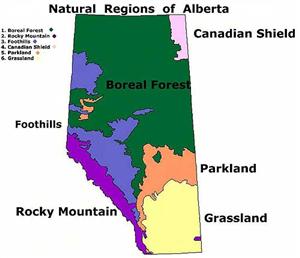Boreal Forest Zones
In Canada, the area known as the boreal forest actually consists of three zones. The boreal zone consists of closed-canopy forest, and supports commercial forestry. This is the zone most people think of when the hear the term “boreal forest”. The taiga lies to the north of the boreal forest, and is a transition zone between the forest and tundra. This zone contains open forest, wetlands, and barren land. Aspen parkland, the third zone, lies to the south of the boreal zone, and is a zone of transition between boreal forest and grasslands. Open forests and grasslands are both found in this zone. In this “Boreal Forest and Biodiversity” section, the term “boreal forest” is used to refer to all three of these zones collectively (WWF 2008).
In Alberta, the boreal forest is the largest natural region in the province. It can be divided into eight natural subregions, although the distinction between some subregions occurs very gradually. While environmental conditions within the boreal forest are generally similar, differences in landscape, climate, soils, vegetation and other factors are found locally and regionally. Alberta’s boreal forest subregions are described briefly below (Alberta MTPR 2006):
- Dry Mixedwood, the warmest subregion, is characterized by undulating plains and aspen-dominated forests and fens.
- Central Mixedwood is the largest subregion in Alberta, and is characterized by upland forests and wetlands on level to gently undulating plains.
- Lower Boreal Highlands are characterized by diverse mixedwood forests on the lower slopes of northern hill systems, and extensive wetlands at the base of the slopes.
- Upper Boreal Highlands are characterized by coniferous forests on the upper slopes and plateaus of the northern hills.
- Athabasca Plain, located south of Lake Athabasca along the Alberta-Saskatchewan border, is characterized by dry, sandy plains, dune fields, and open shrub or jack pine communities.
- Peace-Athabasca Delta, an expanse of lakes, rivers, creeks, marshes, sedge meadows, shrublands, and forests, with warm summers and long, very cold winters.
- Northern Mixedwood is dominated by black spruce bogs and fens, with significant areas of permafrost.
- Boreal Subarctic includes elevated plateaus and open black spruce bogs in far northern Alberta, with short, cool summers and long, very cold winters.









